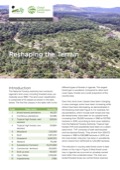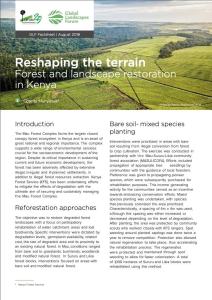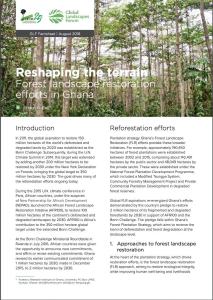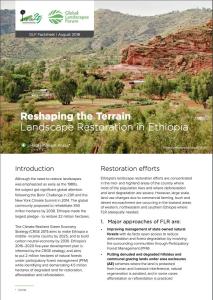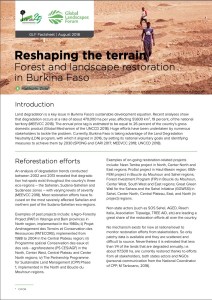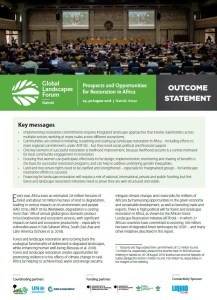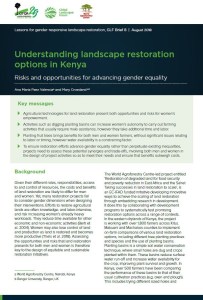Climate change, conflict and crisis in Lake Chad
This year's 2nd edition of the European Security and Defence Union journal is looking into climate change as global security and humanitarian challenge. Janani Vivekananda, Senior Adviser for Climate Change and Peacebuilding at adelphi, has contributed to the journal with a piece on the climate security crisis currently plaguing the Lake Chad basin. Lake Chad is a geophysical and ecological miracle.
Reshaping the terrain: Forest landscape restoration in Uganda
The National Forestry Authority has monitored Ugandas land cover, including forested areas, periodically since 1990. The land cover classification is comprised of 13 classes as shown in the table below. The first five classes in the table refer to the different types of forests in Uganda. The largest forest type is woodland. Compared to other landcover types, forests are a small proportion of the country area.
Reshaping the terrain: Forest and landscape restoration in Kenya
The Mau Forest Complex forms the largest closed canopy forest ecosystem in Kenya and is an asset of great national and regional importance. The complex supports a wide range of environmental services crucial for the socioeconomic development of the region. Despite its critical importance in sustaining current and future economic development, the forest has been adversely affected by extensive illegal, irregular and ill-planned settlements, in addition to illegal forest resources extraction.
Reshaping the terrain Forest and landscape restoration in Cameroon
In 2017, Cameroon committed to restore forests and degraded lands over more than 12 million hectares across all ecosystems by 2030 as part of the African Forest Landscape Restoration Initiative (AFR 100). The fact sheet elaborates on the status of the commitments made and highlights key restoration efforts and major constraints to FLR in practice.
Reshaping the terrain: Landscape restoration in Tanzania
Although Tanzania looks back onto a long history of land degradation, it has seen significant restoration efforts even before the African Forest Landscape Restoration Initiative (AFR 100) was launched. Building on this experience, the fact sheet highlights the main landscape restoration approaches employed in the country and elaborates on the major constraints as well as enabling conditions for FLR.
Reshaping the terrain: Forest landscape restoration efforts in Ghana
As one of the key partners of the African Forest Landscape Restoration Initiative (AFR 100), Ghana is committed to restore 2 million hectares of its land by 2030. In this factsheet, the major approaches to forest landscape restoration are outlined and enabling conditions as well as major constraints to forest landscape restoration elaborated.
Reshaping the Terrain: Landscape Restoration in Ethiopia
With 22 million hectares, Ethiopia by far made the largest pledge to restore its degraded lands under the African Forest Landscape Restoration Initiative (AFR 100). In this fact sheet, restoration efforts are presented including major approaches, key constraints and enabling conditions and steps to achieve FLR in the country.
Reshaping the terrain: Forest and landscape restoration in Burkina Faso
Land degradation poses a major challenge to sustainable development in Burkina Faso. Against this backdrop, the fact sheet explores relevant Forest and Landscape Restoration approaches as well as enabling factors to overcome pertaining constraints for the country to achieve its varied international FLR commitments.
GLF Nairobi 2018 Outcome Statement: Prospects and Opportunities for Restoration in Africa
The outcome statement for GLF Nairobi 2018, featuring the key insights and takeaways from the event that took place August 29-30th.
Building farmer organisations’ capacity to collectively adopt agroforestry and sustainable agriculture land management practices in Lake Victoria Basin
Between 2012 and 2017, Vi Agroforestry and partners supported the development and implementation of the Lake Victoria Farmers’ Organisation Agroforestry (FOA) program. Under this program, and in cooperation with 40 member-based farmer organizations spread across Kenya, Uganda, Tanzania and Rwanda, approximately two million female and male farmers, school children and young people were mobilized to implement agroforestry and sustainable agriculture land management (SALM) practices in different agroecosystems of Lake Victoria catchment areas.
Understanding landscape restoration options in Kenya: Risks and opportunities for advancing gender equality
Given their different roles, responsibilities, access to and control of resources, the costs and benefits of land restoration are likely to differ for men and women. Yet, many restoration projects fail to consider gender dimensions when designing their interventions. Efforts to restore agricultural lands are often knowledge- and labor-intensive, and risk increasing women’s already heavy workloads.



